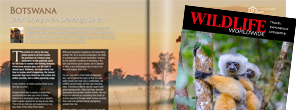Kangaroo Island: Australia’s Wildlife Haven

Exposed to the elements out in the Great Australian Bight and separated from the Fleurieu Peninsula on the mainland by seven miles of open ocean, Kangaroo Island is one of Australia’s true wildlife destinations.
The reason for the profusion of wildlife on Kangaroo Island is precisely its isolation from the mainland. The island has managed to escape much of the damage caused by foreign settlers and colonialism seen in other parts of Australia allowing it to retain over half of its native habitats. Furthermore, the nature of being an island and surrounded by water has also meant that
 Kangaroo Island has avoided the detrimental impacts of introduced species alien to the indigenous ecosystems, such as foxes, rabbits and cane toads, who have had such an negative effect in other regions of the country. Presently, more than an third of Kangaroo Island is dedicated to national parks, conservation and wilderness protection areas, including Flinders Chase National Park which is the largest area of preserved bushland in South Australia. Kangaroo Island is also home to just 4,500 people who, on an island of 4,400 square kilometres are extremely spread out. All of these factors mean that the wildlife on Kangaroo Island continues to thrive and to flourish.
Kangaroo Island has avoided the detrimental impacts of introduced species alien to the indigenous ecosystems, such as foxes, rabbits and cane toads, who have had such an negative effect in other regions of the country. Presently, more than an third of Kangaroo Island is dedicated to national parks, conservation and wilderness protection areas, including Flinders Chase National Park which is the largest area of preserved bushland in South Australia. Kangaroo Island is also home to just 4,500 people who, on an island of 4,400 square kilometres are extremely spread out. All of these factors mean that the wildlife on Kangaroo Island continues to thrive and to flourish.
The island is a refuge to many of Australia’s iconic species, but the whole experience starts with just getting there. There are two ways to reach Kangaroo Island – the first is a short 30-minute domestic flight from Adelaide and the second is a 45-minute ferry ride from Cape Jervis on the mainland to the small town of Penneshaw on the east coast of the island. For wildlife enthusiasts, the ferry is the best choice as the ferry crossing provides an opportunity to spot dolphins and Southern right whales who reside in these waters from late-May until the end of October.
However, it’s once you reach Kangaroo Island when the real wildlife extravaganza begins. For many visitors the first port of call is the famous Seal Bay on the south coast to meet some of the island’s locals. The beach at Seal Bay and the dunes behind are a sanctuary for the third largest colony of endangered Australian sealions in the world. From this incredible location you can observe these personable animals and guided tours on the beach itself can provide a number of memorable encounters with these characterful creatures..

Australian sealions are not the only playful marine mammal on the shores of Kangaroo Island. New Zealand fur seals are also native to the island. Huge numbers of these fur seals gather on Kangaroo Island’s southwesterly point at Cape du Couedic. From here you can see them jumping and frolicking amongst the crashing waves. Be warned though, as it can certainly be rather breezy on this point of the island.
Away from the coast, much of Kangaroo Island is covered in pristine bushland. Within the variety of vegetation, the island has several species of eucalyptus tree whose leaves are the snack of choice for one of Australia’s most endearing animals, the koala. You can spend many an hour wandering between the eucalypts peering upwards into the branches to catch a glimpse of their grey ‘fuzzy’ fur. Once you find them, however, you can really spend as much time as you want watching and photographing as koalas are not really known for their active lifestyles! Koalas can be seen across much of Kangaroo Island, but Hanson Bay Sanctuary regularly offers excellent sightings.
Kangaroo Island also has a fantastic diversity of birdlife; 267 species to be exact.
 Wedge-tailed eagle, little penguin, glossy black cockatoo and Australian pelican are just a few of the avian highlights which you can see. However, no trip to Kangaroo Island is complete without seeing the animal after which the island is named. In the afternoon, kangaroos emerge from the undergrowth and lollop on to the grassy clearings. Usually seen in small groups, the kangaroos spend much of their time grazing or lounging in the afternoon sunshine. In a few places on the island, such as Kelly Hill Conservation Park, you can view the kangaroos whilst enjoying a spot of tea and cake – a very Australian take on a British tradition!
Wedge-tailed eagle, little penguin, glossy black cockatoo and Australian pelican are just a few of the avian highlights which you can see. However, no trip to Kangaroo Island is complete without seeing the animal after which the island is named. In the afternoon, kangaroos emerge from the undergrowth and lollop on to the grassy clearings. Usually seen in small groups, the kangaroos spend much of their time grazing or lounging in the afternoon sunshine. In a few places on the island, such as Kelly Hill Conservation Park, you can view the kangaroos whilst enjoying a spot of tea and cake – a very Australian take on a British tradition!
Often, Kangaroo Island is left out and excluded on many itineraries in Australia. Some feel it is too out of the way and off the tourist trail separated from the other great attractions this country has to offer. Nevertheless, Kangaroo Island is one of the few places in Australia where the wildlife viewing can be as prolific and reliable as Africa and South America which certainly says a lot. With rugged coastal landscapes, hospitable people and a whole host of remarkable species ranging from echidnas to Southern right whales, Kangaroo Island is a treat to behold and should not be missed by anyone who enjoys their nature.
Peruse our trip ideas to Australia's Kangaroo Island - our experienced travel consultants will be happy to design your perfect tailor-made trip to this wildlife haven in South Australia.








